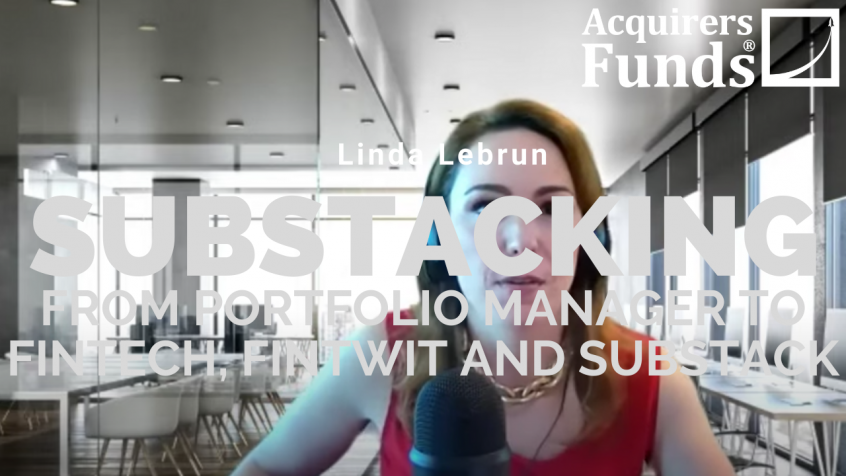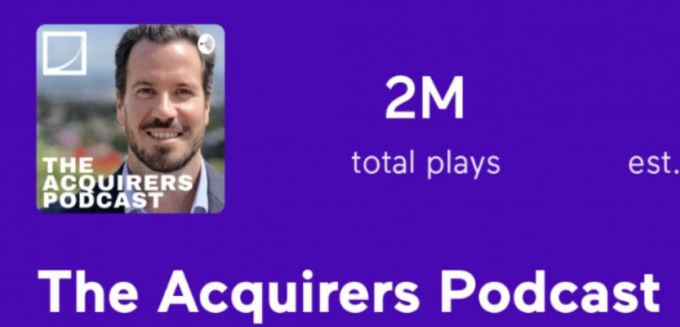In her recent interview on The Acquirers Podcast with Tobias, Linda Lebrun, Director of Finance & Investing Writer Recruitment at Substack, discussed here journey from Portfolio Manager To Substack. Here’s an excerpt from the interview:
Tobias: Let’s talk a little bit about your transition to Substack because I know you through FinTwit and as a small cap manager, and you’ve seen this explosion, I guess, in Substack and you’ve actively sought them out. What was that process like? How did that come about?
Linda: Yeah. I was working as a portfolio manager for a long time, along with the team managing small cap portfolios US and global primarily. Just to give the 30,000-foot view on that, I still am very fascinated by capital markets, and I had the good fortune to work with some terrifically smart people. The joy in life is always the people you work with, and the people were terrific. My issue was with headwinds in the industry due to structural shifts that are not going to be a surprise to anybody. In the US, you have 50% of all assets being managed passively. Canada is always behind the US in trends, but in Canada, it’s about 30%. What that creates is this feed pressure, where it’s harder to attract assets and harder to build a business in fundamental long-only active management, which is what I was doing than it was 20 or even 10 years ago.
It was an environment where it was tough to build and there was the eternal challenge that short of reading transcripts, reading 10-Ks, if you’re trying to invest fundamentally, you are by and large, using the same information to everyone else’s. The question and allocator or consultant will always pose is, what is your edge? Why should I give my money to you and not someone else? Why should I believe that you are going to generate alpha and not someone else? There’s this great chart– CFA society tries to suppress this information, CFA Institute, but the number of charterholders per security, you can go on Michael Badnik’s website and see the chart. The number of CFA charterholders per stock has gone from 5 in the 90s to 50 now, so [chuckles] you have this group of very determined bright people perennially combing over the same. This is why I wanted to do small caps, because I do buy into the idea that small caps are less examined, less loved in many cases, part of the market, but still these trends are going on. If you have a lot of career left, if you’re not near retirement age, you have to sort of sit back and say, “Is the growth going to be more or less or the same as time goes on in this industry?”
At the same time, I was very interested in– I was seeing, being exposed to on Twitter, people who worked at tech startups, and people who are solving problems using tech, so not being a technical person myself, I admired the fact that where an investor is always by the nature of their work, sitting in the stands, watching the action of businesses, watching operators, operators actually on the field in the game. So, there is something attractive about saying, “Well, could there be a way to be on the field?” People listening may partly relate to this, part of the– you have to figure out with the domain knowledge that I have, with the subject matter expertise that I have, that I build up, what do I have to offer? Then this is sometimes it’s a question of somebody who has been doing one thing for a decade, and then you say, “How do I go and move into something else?”
I started to, here in Toronto where I live, network with tech startups and try to meet people who were founding things and running companies. I’ll make a specific recommendation. There’s a lecture series called TechTO here in Toronto, and I started to go to those events. When you go, they’ll have a break, and they’ll say, “Okay, now we’re going to do networking, and you have to meet the person to your left, that’s your right.” “Oh, my God, this is awful. How can I? Just go hide in the bathroom.” I would go and do it and try to meet people.
As I was casting about for ideas, that was when I thought about Substack, because I did know a couple of people who had achieved really good success, building their own business by having a Substack publication and turning it into something that cash flowed enough that it could be the only thing they did. I thought that Substack also, okay, so this is maybe someplace where I can use my domain knowledge and knowing a bit about finance and investing content, and who the players are, and where there might be a win-win situation, where it could be good for Substack because they are attracting more people, and good for the writer because he or she has a better way to monetize and make it a sustainable business.
That was when I made my pitch. I sent a cold email to one of the founders of Substack, to Hamish, and said, “Here are some ideas that I have about things that you could,” and none of them were rocket science. It was things like, “Go on podcasts that are relevant in the industry and talk about Substack.” Things that that they were not doing partly just by nature of being a startup company and not having endless numbers of employees to do these things, but just to say, “Okay, I am somebody who is passionate about these topics, passionate about this area. Maybe I could help get the flywheel going,” which is what you want to try to do as a startup to get people interested in and thinking about what the opportunities are. That’s how I ended up hooking up with them.
You can find out more about Tobias’ podcast here – The Acquirers Podcast. You can also listen to the podcast on your favorite podcast platforms here:
For all the latest news and podcasts, join our free newsletter here.
Don’t forget to check out our FREE Large Cap 1000 – Stock Screener, here at The Acquirer’s Multiple:




